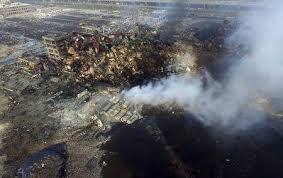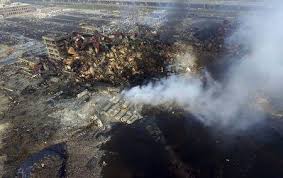
As the Sunday dawned on the Chinese grounds, the soldiers along with numerous rescue workers dressed in hazard suits along with gas masks on their faces rushed to the port of Tianjin, which were a target of an explosion that “flattened part of a national development zone”. The rescue squad are immersed in search of “toxic material” which they are to clear before any rainfall strikes the area. It is indeed a race with nature lest, the rains worsens the situation by creating “further toxic gas”. Moreover, Premier Li Keqiang was also present to express his sympathy.
The disaster took place on last Wednesday, by sending “massive yellow and orange fireballs into the sky”, whereby burning debris were hurled on back to the land which was a “vast industrial area”. Consequently, the fatal debris falling from the sky included blasted shipping containers, shattered windows, crumpled cars and other burnt out objects. The death toll, at present amounts to 112 while 95 people still remain missing. The latter category is mostly comprised of “fire fighters” as claimed by the state media. It is an indicative to the fact that the numbers are still on the rising graph. Moreover, over seven hundred twenty people have already been admitted to the hospital.
Experts have detected “the presence of toxin” in the blast location, although they have assured the people beyond the two kilometre perimeter of the blast that they are in the safe zone, while the areas under threat are under evacuation process. The military authorities have taken up the responsibility to see that the people do not meet with any “secondary damage”.
Nevertheless, there is a large quantity of “deadly sodium cyanide” which needs to be cleared off from the site before any rainfall which could turn the element into toxic gas. Moreover, the water used earlier to bring the fire under control could have possibly “contributed to the blasts, given the volatile nature of the chemicals involved” speculate experts. The good news is that water reservoirs around the blast site are not “severely contaminated with cyanide”, although there the presence of “other hazardous chemicals in water” have been found.
"Greenpeace reiterates its call for authorities to implement a comprehensive survey of hazardous chemicals currently present in air and water supplies and make public all information".
There have been a lot of evacuations, as people near the blast site sought refuge in a school following the change of wind direction which instilled fear of blowing in “toxic chemical particles”. Reports say that around “6,300 people have been displaced by the blasts” sending shockwaves across the entire city. Some people have also protested at the knowledge of finding harmful chemical storage near residence areas.
Furthermore, Reuters reports that:
“Emotional family members of missing fire fighters - 85 of the 95 people missing - also protested, marching to district government offices where they scuffled with police, desperate for answers, before being dispersed.”
References:
http://www.reuters.com/article/2015/08/16/us-china-blast-idUSKCN0QL03920150816
The disaster took place on last Wednesday, by sending “massive yellow and orange fireballs into the sky”, whereby burning debris were hurled on back to the land which was a “vast industrial area”. Consequently, the fatal debris falling from the sky included blasted shipping containers, shattered windows, crumpled cars and other burnt out objects. The death toll, at present amounts to 112 while 95 people still remain missing. The latter category is mostly comprised of “fire fighters” as claimed by the state media. It is an indicative to the fact that the numbers are still on the rising graph. Moreover, over seven hundred twenty people have already been admitted to the hospital.
Experts have detected “the presence of toxin” in the blast location, although they have assured the people beyond the two kilometre perimeter of the blast that they are in the safe zone, while the areas under threat are under evacuation process. The military authorities have taken up the responsibility to see that the people do not meet with any “secondary damage”.
Nevertheless, there is a large quantity of “deadly sodium cyanide” which needs to be cleared off from the site before any rainfall which could turn the element into toxic gas. Moreover, the water used earlier to bring the fire under control could have possibly “contributed to the blasts, given the volatile nature of the chemicals involved” speculate experts. The good news is that water reservoirs around the blast site are not “severely contaminated with cyanide”, although there the presence of “other hazardous chemicals in water” have been found.
"Greenpeace reiterates its call for authorities to implement a comprehensive survey of hazardous chemicals currently present in air and water supplies and make public all information".
There have been a lot of evacuations, as people near the blast site sought refuge in a school following the change of wind direction which instilled fear of blowing in “toxic chemical particles”. Reports say that around “6,300 people have been displaced by the blasts” sending shockwaves across the entire city. Some people have also protested at the knowledge of finding harmful chemical storage near residence areas.
Furthermore, Reuters reports that:
“Emotional family members of missing fire fighters - 85 of the 95 people missing - also protested, marching to district government offices where they scuffled with police, desperate for answers, before being dispersed.”
References:
http://www.reuters.com/article/2015/08/16/us-china-blast-idUSKCN0QL03920150816





